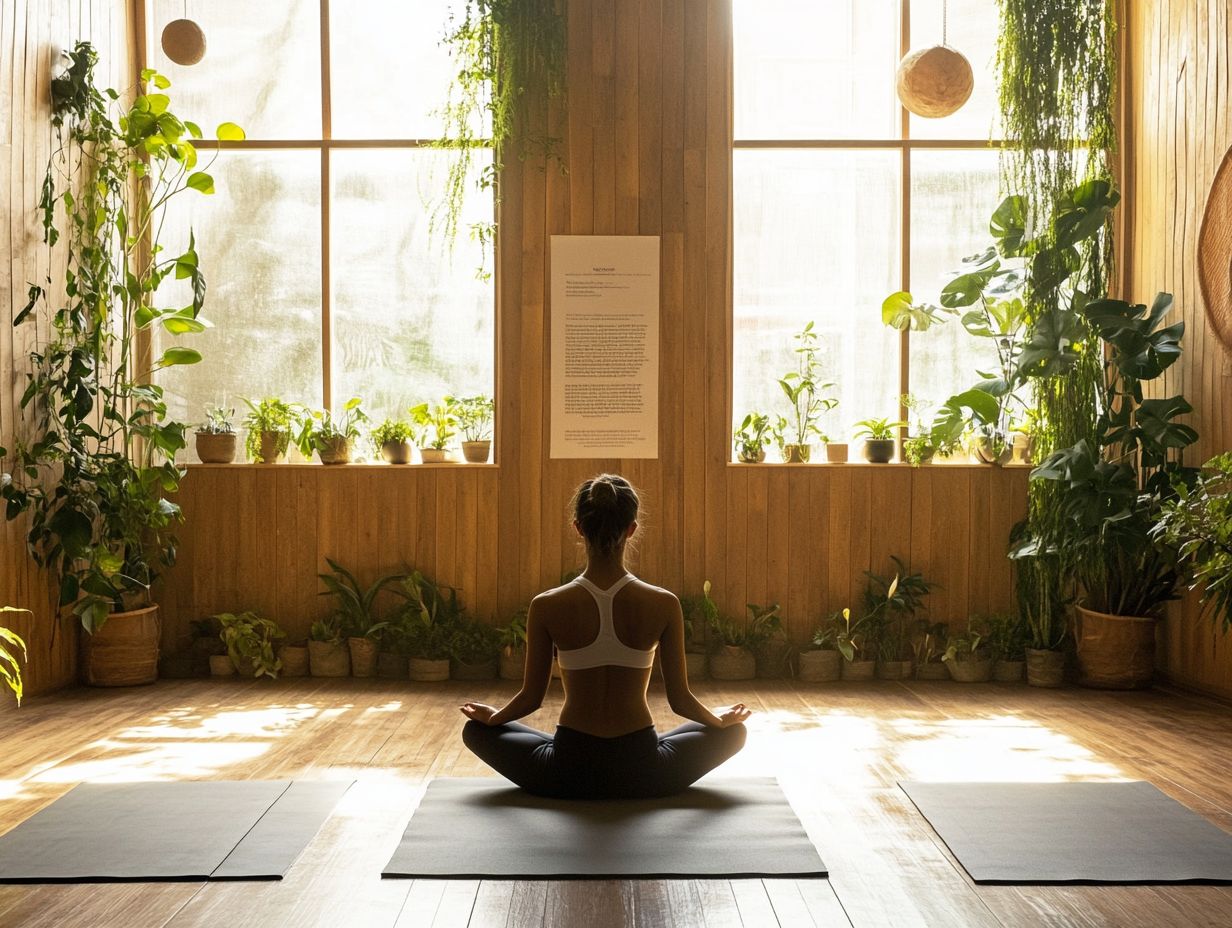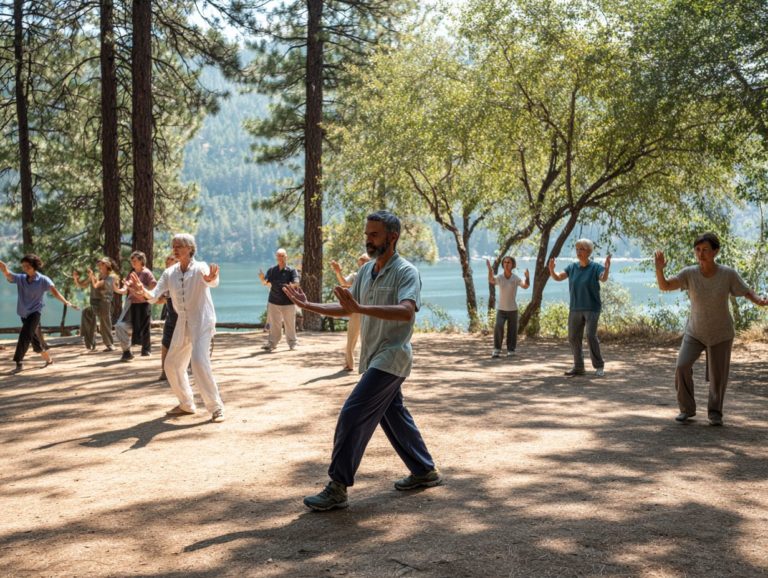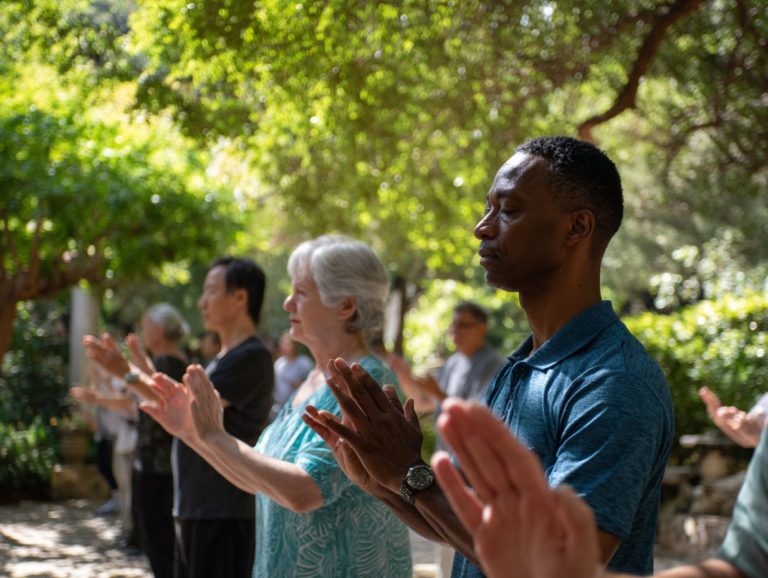How to Get Yoga Certifications: Types and Requirements
In a world where wellness and self-discovery are becoming increasingly important, yoga certifications can open doors to new opportunities and deepen your practice.
With various types of certifications available, such as Registered Yoga Teacher (RYT) and Experienced Registered Yoga Teacher (ERYT) Knowing the current environment is important for new teachers.
This article explores the diverse certification types, the requirements needed to become certified, tips for selecting the right program, and the benefits that come with earning your credentials.
Whether you want to teach or improve your skills, you will find useful information here.
Key Takeaways:
- To become a certified yoga teacher, you can choose from various types of certifications such as RYT, ERYT, and YACEP.
- Requirements for yoga certification include minimum age, completion of a teacher training program, teaching experience, and continuing education.
- When choosing a yoga certification program, consider factors such as accreditation, curriculum, reputation, and cost.
Contents
- 1 What Are The Types Of Yoga Certifications?
- 2 What Are The Requirements For Yoga Certification?
- 3 How To Choose The Right Yoga Certification Program?
- 4 What Are The Benefits Of Getting Yoga Certification?
- 5 Yoga Certification and Participation Statistics 2024
- 5.1 Yoga Participation Statistics: Global Participation
- 5.2 Yoga Participation Statistics: US Yoga Industry
- 5.3 Yoga Participation Statistics: Demographics and Age
- 5.4 Yoga Participation Statistics: Emotional Wellbeing
- 5.5 1. Credibility
- 5.6 2. Career Opportunities
- 5.7 3. Continuing Education
- 5.8 4. Community and Networking
- 6 Frequently Asked Questions
- 6.1 What are the different types of yoga certifications available?
- 6.2 What are the general requirements for obtaining a yoga certification?
- 6.3 Do I need to have a certain level of experience before pursuing a yoga certification?
- 6.4 What is the difference between a 200-hour and a 500-hour yoga certification?
- 6.5 What are the benefits of obtaining a yoga certification?
- 6.6 Are there any additional requirements for obtaining a yoga certification?
What Are The Types Of Yoga Certifications?

Yoga certifications are important credentials for instructors who want to teach different styles and levels. These certifications confirm that instructors meet the standards set by organizations like Yoga Alliance, a well-regarded authority in the yoga community. There’s also this article from Soma Yoga Institute, that shares the best online yoga teach training certifications guide.
Programs for teachers in training focus on improving their skills, knowledge, and teaching methods with detailed lessons, typically ranging from 200 to 500 hours.
Registered Yoga Teacher (RYT) and Experienced Registered Yoga Teacher (E-RYT) are well-known certifications that show a commitment to quality education and ethical teaching.
1. Registered Yoga Teacher (RYT)
A Registered Yoga Teacher (RYT) is someone who has completed a yoga teacher training program that meets the standards set by Yoga Alliance, typically consisting of a minimum of 200 hours of education.
This certification confirms the teacher’s dedication to teaching and shows they have the skills and information needed to lead students well.
By becoming an RYT, instructors gain access to a wealth of teaching opportunities in studios, fitness centers, and wellness retreats around the world.
The thorough training helps students learn yoga principles, human body knowledge, and teaching methods, allowing them to provide a safe and meaningful space for learners.
Yoga Alliance’s approval strengthens the teacher’s reputation and motivates ongoing learning and involvement with others.
2. Experienced Registered Yoga Teacher (ERYT)
The Experienced Registered Yoga Teacher (ERYT) designation is awarded to those who have completed a higher level of yoga teacher training and possess a significant amount of teaching experience beyond the RYT certification.
To qualify for ERYT status, individuals must typically accumulate a minimum of 2,000 hours of teaching experience, which often includes a variety of teaching settings and styles. They may need to engage in continued education, such as specialized workshops or advanced training courses.
Getting ERYT certification has many benefits. It improves your professional reputation and provides more job possibilities.
People with ERYT status are usually seen as leaders in yoga, which can result in teaching advanced classes, guiding new instructors, or running workshops. This helps them grow their careers and increase their impact in yoga.
3. Yoga Alliance Continuing Education Provider (YACEP)
Yoga Alliance Continuing Education Providers (YACEP) offer specialized courses for yoga teachers who want to improve their knowledge and abilities while gaining credits for ongoing education.
These courses are very important for staying ahead in the constantly changing yoga field. By participating in YACEP, instructors can learn about advanced asana techniques, yoga philosophy, and teaching methods for different groups, helping them reach more students.
Continuing education is very important because it helps people improve themselves and raises teaching quality in the community. YACEP courses often include unique formats like workshops and online modules, providing flexibility to fit learning into a busy schedule. For those questioning the significance of formal certifications, this discussion on Quora offers expanded context on why ongoing education remains crucial in maintaining teaching standards.
4. Yoga Alliance Continuing Education Provider (YACEP)
As a Yoga Alliance Continuing Education Provider (YACEP), organizations and instructors can offer workshops, training programs, and classes that satisfy the ongoing education requirements for yoga teachers.
This status improves the reputation of instructors and schools while providing teachers with a clear way to improve their skills and teaching methods.
YACEP provides various workshops that help educators learn new teaching methods and stay updated on the newest trends in the field.
Teachers can customize their training based on what they are interested in and what their students need, helping them stay current in a constantly changing area.
As a result, both teachers and their schools can create an environment of ongoing learning, leading to better experiences and results for students.
What Are The Requirements For Yoga Certification?
To get a yoga certification, aspiring teachers need to fulfill key criteria that differ depending on the program and level of certification.
These include being a certain age, finishing a specified yoga teacher training program, and completing a required number of teaching hours to gain enough experience. For those curious about globally recognized certifications, Quora provides insights into the most widely accepted yoga certifications, adding valuable perspective for aspiring teachers looking to compare their options.
1. Minimum Age
One basic rule for getting a yoga teaching certificate is that applicants must be at least 18 years old. This age requirement is in place to make sure they have the maturity needed to teach.
This age limit is important because it shows a level of life experience that is important when working with different groups of students.
Young adults are likely to have encountered various challenges that can shape their approach to teaching, instilling confidence and empathy in their practice.
These age requirements matter because they involve handling emotions and managing situations in the classroom.
Assessing someone’s professional readiness at this stage can prevent potential issues in a teaching environment, where responsibility and the capacity to inspire and guide others are paramount.
2. Completion Of A Yoga Teacher Training Program
Completion of a yoga teacher training program is a fundamental requirement for certification, with programs varying in duration from 200 hours to 500 hours, depending on the level of certification being pursued.
Joining a structured training course helps upcoming teachers learn important subjects such as philosophy, anatomy, teaching methods, and practical teaching experience.
A reputable program, whether it lasts 200 hours or 500 hours, provides important knowledge and helps build the confidence and skill needed to lead others in their yoga practice.
While a 200-hour program typically covers foundational skills and techniques, a 500-hour curriculum often encompasses advanced practices, including specialized styles and deeper explorations of the business side of yoga.
So, picking the right program is important for improving and being successful as a teacher.
3. Teaching Experience

Teaching experience is an important part of the yoga certification process, as candidates may need to record a set number of teaching hours to qualify for advanced certifications like ERYT.
This practical experience helps upcoming teachers improve their abilities and make difficult ideas easier for students to grasp.
Usually, most programs require about 1,000 hours of teaching practice, which is important for developing confidence and skill. Working with different groups helps future teachers adjust their teaching methods to suit different learning styles and preferences, which enhances their skills.
Practical learning strengthens community ties and connection, enabling them to better support their students in their individual yoga practice.
4. Continuing Education
Continuing education is essential for yoga teachers to maintain their certification, as it allows them to stay updated on new techniques, ethics, and safety practices in the field.
Continuing to learn helps improve teaching skills and provides a better grasp of yoga philosophy and anatomy. Organizations like Yoga Alliance require teachers to complete specific continuing education hours every three years, which may include different classes.
These may range from specialized workshops focusing on advanced asanas and adjustments to modules on teaching methodologies and mindfulness practices. Workshops covering subjects such as yoga that considers trauma, business knowledge for yoga teachers, or projects to connect with the community also count.
By using these educational programs, teachers fulfill their responsibilities and become better at helping their students.
How To Choose The Right Yoga Certification Program?
Choosing a yoga certification program involves considering accreditation, course content, the school’s reputation, and the fees. These elements influence the education quality and opportunities for teaching later.
1. Accreditation
Accreditation is an important part of picking a yoga certification program. Programs approved by Yoga Alliance make sure the training follows set standards for teaching education.
When you choose an accredited program, you receive top-notch education, which means your qualifications are accepted by multiple studios and organizations.
Being acknowledged is important for developing a strong career, as employers often look for teachers who have finished approved training.
Accreditation shows dedication to continuous learning and following ethical standards, which are becoming more important in the competitive field of yoga teaching.
Thus, knowing the importance of accreditation and giving it priority can greatly improve a yoga teacher’s credibility and create many opportunities in the industry.
2. Curriculum
The curriculum of a yoga certification program is important to look at, as it should cover a complete study of different yoga techniques, anatomy, safety, transitions, and teaching methods.
A complete program helps effective teaching and promotes the physical and mental well-being of teachers and students.
Key topics like safety rules help practitioners perform poses safely, preventing injuries. A detailed study of anatomy helps understand the body’s movements, aiding in achieving proper alignment and technique.
Incorporating specific yoga styles like Hatha and Vinyasa prepares individuals with diverse teaching skills, allowing them to cater to various student needs and preferences.
A diverse and rich curriculum promotes both knowledge and confidence in aspiring instructors.
3. Reputation
The reputation of a yoga school can significantly influence the effectiveness of a certification program, as schools with a strong standing often have established networks that benefit their graduates.
Picking a respected school can lead to better job opportunities since many employers often favor applicants from well-known training programs.
A respected yoga school frequently provides workshops, opportunities for mentorship, and collaboration with experienced instructors, all contributing positively to a student’s education.
The quality of education is often linked to how well-known the school is. The best schools employ knowledgeable teachers and have thorough programs that cover yoga’s physical aspects, along with its philosophy, body structure, and different ways to teach.
4. Cost
Cost is an important consideration when selecting a yoga certification program, as fees can vary widely depending on the school’s location, duration of the training, and additional resources provided.
Prospective students should also take into account factors such as the reputation of the instructor, the size of the class, and whether accommodations are included in the program fees.
This analysis examines costs in detail, showing how a well-structured program can provide better clarity and networking opportunities, which can aid in career advancement later.
People should align their financial plans with their career aspirations, ensuring the certification they select is within their budget and supports their professional objectives in the yoga field.
What Are The Benefits Of Getting Yoga Certification?
Getting yoga certification provides many advantages.
It can improve your reputation as a teacher, open up more job options, and connect you with other instructors and materials for ongoing learning.
Yoga Certification and Participation Statistics 2024
Yoga Certification and Participation Statistics 2024

Yoga Participation Statistics: Global Participation
Yoga Participation Statistics: US Yoga Industry
Yoga Participation Statistics: Demographics and Age
Yoga Participation Statistics: Emotional Wellbeing
The Yoga Certification and Participation Statistics 2024 gives a detailed look at yoga worldwide and within the country, showing increased involvement, demographic information, and the mental health advantages linked to practicing yoga.
Yoga Participation Statistics reveal an impressive figure of 300 million practitioners worldwide, marking a substantial 63.8% growth over the last 12 years. This growth is reflective of yoga’s increasing popularity and its global acceptance as a beneficial practice for both physical and mental wellbeing. In the United States alone, yoga practitioners have grown by 64%, reaching 34.4 million people in 2021. The U.S. yoga industry holds a significant value of $37.46 billion in 2019, demonstrating its economic influence and the potential for continued expansion.
- Demographics and Age: The statistics show that women make up 23% of yoga practitioners, indicating a strong female presence in the practice. Interestingly, there has been a 150% increase in male participation from 2012 to 2022, suggesting a growing acceptance and appeal among men. The age group of 30-49 years represents 43% of practitioners, highlighting this demographic’s interest in maintaining health and wellness through yoga.
Furthermore, yoga’s impact on Emotional Wellbeing is substantial. A significant 86% of practitioners report a reduction in stress, and 69% experience improved mood and temperament. These benefits underline yoga’s role in enhancing mental health and emotional resilience, contributing to its widespread adoption.
Overall, the data shows yoga’s rise as an important practice both worldwide and in the U.S. The growing variety of people who practice yoga, along with mental health benefits backed by evidence, indicates that yoga will remain a key element in lifestyle and wellness trends. The industry’s economic growth supports this trend, showing strong possibilities for businesses and educators in yoga. As more people choose yoga for overall well-being, it is expected to continue growing in popularity, impacting health and wellness industries globally.
1. Credibility
One main benefit of getting a yoga certification is the increased trust it gives to teachers, helping them to be seen as knowledgeable and ethical instructors.
This improved reputation influences how potential students view them, often leading to trust and eagerness to learn from the instructor.
When students feel confident in their teacher’s qualifications, they are more likely to participate actively in classes and follow their guidance both on and off the mat.
Credibility can lead to greater professional recognition within the yoga community, opening doors to more teaching opportunities and collaborations.
As certified instructors establish their reputations, they can create a stronger connection with students, leading to an energetic and respectful yoga setting.
2. Career Opportunities
Yoga certification opens various career opportunities for instructors, enabling them to teach classes at studios, gyms, wellness centers, and even online platforms.
As the popularity of yoga continues to rise, there is an increasing demand for qualified teachers who can guide students through their practice.
Instructors can offer private lessons, workshops, or retreats to meet the needs of different audiences and environments.
Many certified teachers decide to focus on particular areas such as prenatal yoga, therapy-based practices, or children’s yoga. This helps them to address particular groups and improve their abilities.
The variety of modern teaching environments, from corporate settings to outdoor classes, helps yoga instructors build a career that matches their personal values and lifestyle.
3. Continuing Education
Yoga certification encourages continuing education, providing instructors access to various resources and workshops that promote skill development and ethical teaching practices.
Regular learning is important for personal development and keeping up with the changing trends and methods in the yoga community.
YACEP programs, along with many other options for ongoing learning, provide instructors with training in specific areas like anatomy, meditation, and mindfulness to meet their varied needs.
These programs help instructors improve their teaching methods, gain more knowledge of yoga philosophy, and make safer, more welcoming spaces for their students.
When they connect with other teachers, these educators find great chances to network, work together, and get support, which strengthens the yoga community overall.
4. Community and Networking

Joining a yoga certification program lets instructors connect with others, exchange experiences, and get helpful feedback on their teaching.
This interaction improves their skills and helps newcomers feel included in a way that can greatly change their experience.
Working with other yoga fans lets teachers share thoughts, learn various teaching styles, and get motivated by each other’s experiences.
People in this community often find mentors who provide guidance, which is important at the beginning of their careers.
Participating in workshops and community events as part of the certification program helps create stronger bonds.
It allows instructors to learn from one another in an encouraging environment that helps them grow both personally and professionally.
Frequently Asked Questions
What are the different types of yoga certifications available?
There are different yoga certifications, such as 200-hour, 300-hour, and 500-hour training programs. There are also specialized certifications for specific styles, such as Vinyasa, Hatha, and Kundalini yoga.
What are the general requirements for obtaining a yoga certification?
The general requirements for obtaining a yoga certification vary, but typically include completing a certain number of hours of training, passing a written exam, and demonstrating proficiency in teaching and practicing various poses.
Do I need to have a certain level of experience before pursuing a yoga certification?
Some programs may require a certain amount of yoga experience before enrolling, but many programs are open to students of all levels. It is important to research the specific requirements of the program you are interested in.
What is the difference between a 200-hour and a 500-hour yoga certification?
The main difference between a 200-hour and a 500-hour yoga certification is the number of hours of training required. To teach yoga, you need at least a 200-hour certification. A 500-hour certification provides more detailed training and can be needed for higher-level teaching roles.
What are the benefits of obtaining a yoga certification?
Getting a yoga certification lets you teach yoga professionally and gives you more knowledge about the practice. It can also open up opportunities for further career advancement and specialization in specific styles of yoga.
Are there any additional requirements for obtaining a yoga certification?
Some programs may require a certain number of teaching hours, as well as continuing education courses, in order to maintain your certification. It is important to research the specific requirements and duties of maintaining your certification after completing the initial training program.

Sheetal Sharda has a background in CS. She got an interest in Holistic living back in 2018, and has since started exploring more into Naturapathy, Holistic Living, Yoga, and more. She got inspired to start SereneClinics to help people find reliable centers across the world.






